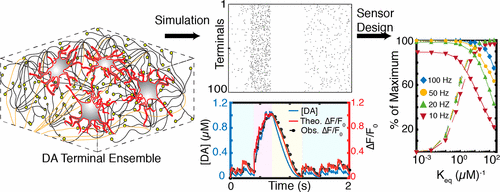当前位置:
X-MOL 学术
›
ACS Chem. Neurosci.
›
论文详情
Our official English website, www.x-mol.net, welcomes your
feedback! (Note: you will need to create a separate account there.)
Stochastic Simulation of Dopamine Neuromodulation for Implementation of Fluorescent Neurochemical Probes in the Striatal Extracellular Space
ACS Chemical Neuroscience ( IF 4.1 ) Pub Date : 2017-08-15 00:00:00 , DOI: 10.1021/acschemneuro.7b00193 Abraham G. Beyene 1 , Ian R. McFarlane 1 , Rebecca L. Pinals 1 , Markita P. Landry 1, 2, 3
ACS Chemical Neuroscience ( IF 4.1 ) Pub Date : 2017-08-15 00:00:00 , DOI: 10.1021/acschemneuro.7b00193 Abraham G. Beyene 1 , Ian R. McFarlane 1 , Rebecca L. Pinals 1 , Markita P. Landry 1, 2, 3
Affiliation

|
Imaging the dynamic behavior of neuromodulatory neurotransmitters in the extracelluar space that arise from individual quantal release events would constitute a major advance in neurochemical imaging. Spatial and temporal resolution of these highly stochastic neuromodulatory events requires concurrent advances in the chemical development of optical nanosensors selective for neuromodulators in concert with advances in imaging methodologies to capture millisecond neurotransmitter release. Herein, we develop and implement a stochastic model to describe dopamine dynamics in the extracellular space (ECS) of the brain dorsal striatum to guide the design and implementation of fluorescent neurochemical probes that record neurotransmitter dynamics in the ECS. Our model is developed from first-principles and simulates release, diffusion, and reuptake of dopamine in a 3D simulation volume of striatal tissue. We find that in vivo imaging of neuromodulation requires simultaneous optimization of dopamine nanosensor reversibility and sensitivity: dopamine imaging in the striatum or nucleus accumbens requires nanosensors with an optimal dopamine dissociation constant (Kd) of 1 μM, whereas Kds above 10 μM are required for dopamine imaging in the prefrontal cortex. Furthermore, as a result of the probabilistic nature of dopamine terminal activity in the striatum, our model reveals that imaging frame rates of 20 Hz are optimal for recording temporally resolved dopamine release events. Our work provides a modeling platform to probe how complex neuromodulatory processes can be studied with fluorescent nanosensors and enables direct evaluation of nanosensor chemistry and imaging hardware parameters. Our stochastic model is generic for evaluating fluorescent neurotransmission probes, and is broadly applicable to the design of other neurotransmitter fluorophores and their optimization for implementation in vivo.
中文翻译:

纹状体细胞外空间中实施荧光神经化学探针的多巴胺神经调节的随机模拟
成像由单个定量释放事件引起的细胞外空间中神经调节神经递质的动态行为,将构成神经化学成像的重大进展。这些高度随机的神经调节事件的空间和时间分辨率需要与对捕获毫秒级神经递质释放的成像方法学相一致的,对神经调节剂具有选择性的光学纳米传感器的化学开发方面的同步进展。本文中,我们开发并实现了一个随机模型来描述大脑背侧纹状体的细胞外空间(ECS)中的多巴胺动力学,以指导荧光神经化学探针的设计和实现,该探针在ECS中记录神经递质的动力学。我们的模型是根据第一性原理开发的,可以模拟释放,扩散,并在纹状体组织的3D模拟体积中重新摄取多巴胺。我们发现体内的神经调节成像需要同时优化多巴胺纳米传感器的可逆性和敏感性:纹状体或伏隔核中的多巴胺成像需要具有最佳多巴胺解离常数的纳米传感器(K d)为1μM,而前额叶皮层中的多巴胺成像则需要K d s大于10μM。此外,由于纹状体中多巴胺末端活性的概率性质,我们的模型显示,20 Hz的成像帧速率最适合记录暂时分辨的多巴胺释放事件。我们的工作提供了一个建模平台,以探讨如何使用荧光纳米传感器研究复杂的神经调节过程,并能够直接评估纳米传感器的化学性质和成像硬件参数。我们的随机模型是用于评估荧光神经传递探针的通用模型,可广泛应用于其他神经递质荧光团的设计及其在体内实施的优化。
更新日期:2017-08-15
中文翻译:

纹状体细胞外空间中实施荧光神经化学探针的多巴胺神经调节的随机模拟
成像由单个定量释放事件引起的细胞外空间中神经调节神经递质的动态行为,将构成神经化学成像的重大进展。这些高度随机的神经调节事件的空间和时间分辨率需要与对捕获毫秒级神经递质释放的成像方法学相一致的,对神经调节剂具有选择性的光学纳米传感器的化学开发方面的同步进展。本文中,我们开发并实现了一个随机模型来描述大脑背侧纹状体的细胞外空间(ECS)中的多巴胺动力学,以指导荧光神经化学探针的设计和实现,该探针在ECS中记录神经递质的动力学。我们的模型是根据第一性原理开发的,可以模拟释放,扩散,并在纹状体组织的3D模拟体积中重新摄取多巴胺。我们发现体内的神经调节成像需要同时优化多巴胺纳米传感器的可逆性和敏感性:纹状体或伏隔核中的多巴胺成像需要具有最佳多巴胺解离常数的纳米传感器(K d)为1μM,而前额叶皮层中的多巴胺成像则需要K d s大于10μM。此外,由于纹状体中多巴胺末端活性的概率性质,我们的模型显示,20 Hz的成像帧速率最适合记录暂时分辨的多巴胺释放事件。我们的工作提供了一个建模平台,以探讨如何使用荧光纳米传感器研究复杂的神经调节过程,并能够直接评估纳米传感器的化学性质和成像硬件参数。我们的随机模型是用于评估荧光神经传递探针的通用模型,可广泛应用于其他神经递质荧光团的设计及其在体内实施的优化。











































 京公网安备 11010802027423号
京公网安备 11010802027423号